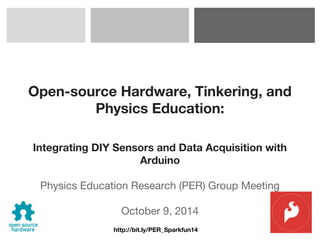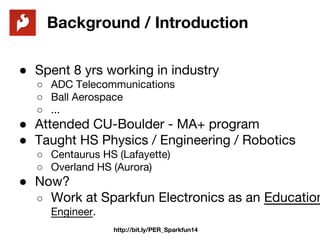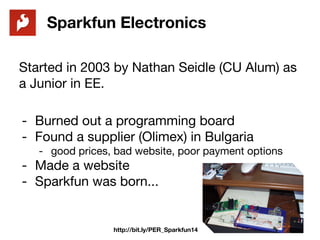Open-Source Hardware, Tinkering, and Physics Education
- 1. http://bit.ly/PER_Sparkfun14 Open-source Hardware, Tinkering, and Physics Education: Integrating DIY Sensors and Data Acquisition with Arduino Physics Education Research (PER) Group Meeting October 9, 2014
- 2. http://bit.ly/PER_Sparkfun14 Background / Introduction â—Ź Spent 8 yrs working in industry â—‹ ADC Telecommunications â—‹ Ball Aerospace â—‹ ... â—Ź Attended CU-Boulder - MA+ program â—Ź Taught HS Physics / Engineering / Robotics â—‹ Centaurus HS (Lafayette) â—‹ Overland HS (Aurora) â—Ź Now? â—‹ Work at Sparkfun Electronics as an Education Engineer.
- 3. http://bit.ly/PER_Sparkfun14 What I do now? Education Engineer at Sparkfun Electronics. - Design and lead professional development workshops for teachers / educators. - Develop curriculum, activities, projects for classroom use.
- 4. http://bit.ly/PER_Sparkfun14 Sparkfun Electronics Started in 2003 by Nathan Seidle (CU Alum) as a Junior in EE. - Burned out a programming board - Found a supplier (Olimex) in Bulgaria - good prices, bad website, poor payment options - Made a website - Sparkfun was born...
- 7. http://bit.ly/PER_Sparkfun14 What the EDU team does here... Promote “tinkering” and messing around with hardware, microcontrollers, and circuits to empower people to build and make new things! Support formal & informal education built around making things -- whether with code, electronics, or physical fabrication.
- 9. http://bit.ly/PER_Sparkfun14 What is Physics? “...physics is about asking fundamental questions and trying to answer them by observing and experimenting.”
- 10. http://bit.ly/PER_Sparkfun14 Craft Tech Inspired Copper Tape & Basic Circuits Using Copper Tape, resistive ink (Bare Conductive) to build paper circuits provides a 1:1 analogue between the circuit diagram and the actual circuit.
- 11. http://bit.ly/PER_Sparkfun14 With which you can now make... https://learn.sparkfun.com/resources/68
- 12. http://bit.ly/PER_Sparkfun14 Ohms Law & Conductivity?
- 13. http://bit.ly/PER_Sparkfun14 Copper Tape Investigations Parallel vs. Series Circuits Ohm’s Law → Is the adhesive conductive? - Design and implement an experiment w/ data to support your conclusion. Paper PCB?
- 14. http://bit.ly/PER_Sparkfun14 Copper Tape + ATtiny85 (Arduino- compatible 8-pin DIP)
- 15. http://bit.ly/PER_Sparkfun14 For comparison: - Apple II : 1 MHz clock, 4K RAM - IBM XT (8088) : 4.77 MHz, 128K RAM In 2005 -- Enters Arduino → 8-bit, 16 MHz Microcontroller, 32K flash, 2K EEPROM Arduino is a low-cost, open source, easily programmable device → operates on as low as 3V -- 2 AA batteries
- 16. Arduino Board “Strong Friend” Created in Ivrea, Italy in 2005 by Massimo Banzi & David Cuartielles Open Source Hardware Processor Coding is accessible & transferrable → (C++, Processing, java)
- 18. http://bit.ly/PER_Sparkfun14 Let’s try something new… http://codebender.cc
- 20. http://bit.ly/PER_Sparkfun14 Hello World! Blinking an LED → 3 instructions (functions) to know: pinMode([pinNum], [INPUTOUTPUT]); digitalWrite([pinNum], [HIGHLOW]); delay([time_ms]) https://codebender.cc/sketch:52993
- 21. http://bit.ly/PER_Sparkfun14 Let’s see what this all looks like? https://codebender.cc/sketch:52993
- 22. http://bit.ly/PER_Sparkfun14 Open Challenges ● How fast can you blink an LED? How fast can you see it blink? ● Morse Code Challenge -- … --- … ● Heartbeat → Halloween is right around the corner! ● Make a light sculpture?
- 23. http://bit.ly/PER_Sparkfun14 Dos Pueblos Engineering Academy Light Sculpture project
- 24. http://bit.ly/PER_Sparkfun14 We’re physicists, right? Let’s talk data... 8-bit Microcontroller → handles 8-bit, 16-bit, and 32-bit data types: byte / char: 0 to 255 / -128 to 127 int / unsigned int: -32,768 to 32,767 long / unsigned long: +/- 2^31 float: decimal values
- 25. http://bit.ly/PER_Sparkfun14 My first project → ReactionTimer https://codebender.cc/sketch:51229
- 26. http://bit.ly/PER_Sparkfun14 Why I like the Reaction Timer - Data is personally meaningful. - Emphasizes accuracy / error / uncertainty in measurement. - As a tool -- it gives students to ask more questions… - Physics is about measurement, observations, and patterns.
- 27. http://bit.ly/PER_Sparkfun14 What all can we do with this? â—Ź Nature of Science: Real data is messy! â—Ź Nature of Science: Variance / Error Analysis / Statistics? â—Ź Kinematics: Reaction Time vs. stopping distance â—Ź Kinematics: Reaction Time vs. falling distance â—Ź Add Sound -- Using tone() command and a buzzer -- does it sound make a difference? â—Ź Other ideas? How about experimental design?
- 28. http://bit.ly/PER_Sparkfun14 “New” vocabulary / concepts for physics teachers - Microcontrollers - void setup() / void loop() ??? - Vcc and GND - Clock speeds - Analog vs. Digital - A/D Converter & Sampling - Pulse Width Modulation (PWM)
- 29. http://bit.ly/PER_Sparkfun14 Other fun demos / activities: Simiple Fading → https://codebender.cc/sketch:53011 Button Fading → https://codebender.cc/sketch:7977 Button Tones → https://codebender.cc/sketch:53013 Color Mixing → https://codebender.cc/sketch:53012
- 30. http://bit.ly/PER_Sparkfun14 A different way of drawing circuits? Vcc ANALOG INPUT (A0) GND 6 Analog Input “channels” 10-bit A/D -> resolution of ~48.9 mV Empirical testing: ~115 uS per measure ~7.3 kHz max sampling rate https://codebender.cc/sketch:53064
- 31. http://bit.ly/PER_Sparkfun14 RC Time Constant Meas. https://codebender.cc/sketch:51144 Vmax = 5V
- 32. http://bit.ly/PER_Sparkfun14 All of the other stuff I didn’t talk about... - Integration with Arduino & Vernier. - Robotics (mechatronics) → what better way to teach kinematics, forces, rotational motion? - ATtiny85 -- the “tiny” Arduino - Voltage vs. Current vs. Power vs. Energy - RF Wireless transmission RSSI & inverse square losses.
- 33. http://bit.ly/PER_Sparkfun14 Physics Education & Reform Interested in piloting / researching new methods in lab & physics education reform - Develop new ideas and identify where these fit in “traditional” physics (& engineering) education. - Increase engagement & participation for ALL students. - Encourage, Inspire, and Motivate “tinkering,” play, and creativity!




















![http://bit.ly/PER_Sparkfun14
Hello World!
Blinking an LED → 3 instructions (functions) to
know:
pinMode([pinNum], [INPUTOUTPUT]);
digitalWrite([pinNum], [HIGHLOW]);
delay([time_ms])
https://codebender.cc/sketch:52993](https://image.slidesharecdn.com/pertalk-open-sourcehardwaretinkeringandphysicseducation-141009213929-conversion-gate01/85/Open-Source-Hardware-Tinkering-and-Physics-Education-20-320.jpg)














